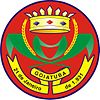|
Goiatuba
Goiatuba is a municipality in south-central Goiás state, Brazil. The population was 34,202 (2020 IBGE) in a total area of 2,470.3 km2. Goiatuba is a large producer of grains, especially soybeans and corn. Climate and LocationThe average elevation is 775 meters, with an annual temperature average of 22 °C. The climate is typically tropical, moist and hot, with well-defined dry and rainy seasons. Average temperatures vary between 19 °C and 30 °C. Goiatuba is about 50 kilometers north of the Paranaíba River, which forms the boundary with the state of Minas Gerais. It is 10 kilometers from the important interstate highway BR-153, which links Itumbiara with the state capital, Goiânia. The distance to Goiânia is 176 kilometers. Municipal boundaries are:
Demographics
EconomyThe economy is based on agriculture and cattle raising, but Goiatuba has several large enterprises. The areas are diverse: poultry processing, automobile sales, dairy products, and agricultural equipment. There is an alcohol distillery—Goiasa (Goiatuba Álcool ltda.), a seed producer—Sementes Selecta, a bed clothing factory—Bouquet, a dairy—Laticínio Polenghi (which produces most of the ice cream sold by McDonald's in Brazil), and two fertilizer plants—Adubos Sul Goiano, Adubos Terra Verde. Economic data
Industrial Dairies
Main agricultural activities
Education and health
(Sepin/IBGE) Political informationMayor: Reinaldo Cândido da Silva (January 2013) City council: 9 ProsperityThe municipality is one of the most prosperous in the state. Goiatuba got a score of 0.812 on the UN Human Development Index, putting it in 4th place out of 242 municipalities in the state. Nationally it was ranked 350 out of 5,507 municipalities. For the complete list see Frigoletto Origin of the nameGoiatuba became a city in 1931, and the origin of the name is curious: "Goia" comes from the Goia Indians and "Tuba" is a Tupi-Guarani word meaning "big". So, Goiatuba is the same as "big Goiás". HistoryThe settlement of the region took place in 1860 when ranchers from Minas Gerais settled to raise cattle and grow crops. In 1892 land was donated to establish a town. The first name was "Bananeiras" because of the abundance of this fruit in the region. With the building of the first chapel the town was called São Sebastião das Bananeiras. In 1900 it was elevated to a district and became a municipality in 1931. See alsoReferences |
||||||||||||||||||||||||||||||||||||||||||||||||
Portal di Ensiklopedia Dunia



